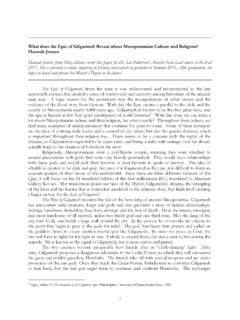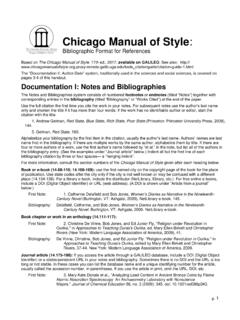Transcription of Veiled Women: Hijab, Religion, and Cultural Practice
1 Veiled women : hijab , religion , and Cultural Practice Sara Slininger omen s fashion is a major business that fuels the world economy. Each year women spend thousands of dollars to stay in fashion. In the Middle East and other Islamic countries the veil, or hijab , which covers the head, body, or face, is a predominant feature of women s It is not, however, a simple fashion accessory, but is a representation of religion and culture. Many people outside of Islam have come to believe that Muslim women are being forced into wearing veils by a predominantly patriarchal society; women who wear the hijab argue that it is their choice to do so. From the origins of veiling, the different styles, and how it is viewed in today s world we can get a better understanding of what the veil means to Islamic societies.
2 Islam was not the first culture to Practice veiling their women . Veiling practices started long before the Islamic prophet Muhammad was born. Societies like the Byzantines, Sassanids, and other cultures in Near and Middle East practiced There is even some evidence that indicates that two clans in southwestern Arabia practiced veiling in pre-Islamic times, the Ban Ism l and Ban Qa n. Veiling was a sign of a women s social status within those societies. In Mesopotamia, the veil was a sign of a woman s high status and respectability. women wore the veil to distinguish Sara Slininger is from Centralia, Illinois.
3 A senior history major with teacher licensure, she wrote Veiled women : hijab , religion , and Cultural Practice for Dr. Brian Mann s Early Islamic History course in the fall 2013 semester. 1 " hijab ," In The Oxford Dictionary of Islam , edited by John L. Esposito, Oxford Islamic Studies Online, e839 (accessed 5-Dec-2013). 2 Fadwa El Guindi and Sherifa Zuhur, " ij b," In The Oxford Encyclopedia of the Islamic World, Oxford Islamic Studies Online, (accessed 5-Dec-2013). W Slininger 69 themselves from slaves and unchaste In some ancient legal traditions, such as in Assyrian law, unchaste or unclean women , such as harlots and slaves, were prohibited from veiling themselves. If they were caught illegally veiling, they were liable to severe The Practice of veiling spread throughout the ancient world the same way that many other ideas traveled from place to place during this time: invasion.
4 When one culture invades another culture there is often some fusion in the Cultural practices of the people. As the Greek, Persian, and Mesopotamian empires mixed with the Semitic peoples of the Middle East, there appeared a subsequent effect that these cultures adopted the Practice of veiling The adoption of veiling by the Semitic people is evidenced in several biblical verses6: When Rebekah looked up and saw Rebekah covered her face with her veil; 7 Also, On that day of judgment the Lord will strip away everything that makes her beautiful; , earrings, bracelets and veils. 8 1 Corinthians 11:3-7 provides the most evidence for the early Christian veiling Practice : But there is one thing I want you to know.
5 The head of every man is Christ, the head of women is man, and the head of Christ is God. A man dishonors Christ if he covers his head while praying or prophesying. But a woman dishonors Christ if she prays or prophesies without a covering on her head, for this is the same as shaving her head. Yes, if she refuses to wear a head covering, she should cut off all her hair! But since it is shameful for a woman to have her hair cut or her head shaved, she should wear a covering. A man should not wear anything on his head when worshiping, for a man is made in God s image and reflects God s glory. And a woman reflects man s glory. 3 Ibid.
6 4 Ibid. 5 Ibid. 6 Ibid. 7 Genesis 24:65 8 Isaiah 3:18-19 Historia 2014 70 These verses show the importance that early Jews and Christians placed on covering a woman s head. A woman who did not veil herself would dishonor herself and Christ; she would also dishonor her husband or other male relatives, because a woman reflects man s glory and a man reflects God s glory. During the time of Muhammad, veiling was not widespread; only his wives and upper-class women wore the veil as a symbol of their Muhammad had many enemies that were out to harm him or his family. In order to protect them, and other members of Muhammad s household, the women Veiled themselves to conceal their identity from Verse 33:53 of the Qur an is known as the hijab verse. It is believed that the revelation for this verse came down after some wedding guests had overstayed their welcome at the nuptial celebration in Zaynab s house.
7 11 O Ye who believe! Enter not the dwellings of the Prophet for a meal without waiting for the proper time, unless permission be granted when ye ask of them (the wives of the Prophet) anything, ask it of them from behind a curtain. That is purer for your hearts and for their Before the hijab verse was taught, Muhammad s wives took part fully in the communal affairs of Other women of the community were not forced to It was not until a generation later, after Muhammad s death that Islamic women started veiling It was no longer confined to the upper 9 John L. Esposito, "Customs and Culture," In What Everyone Needs to Know About Islam, Oxford Islamic Studies Online, com/article/book/acprof-9780199794133/ac prof-9780199794133-div1-58 (accessed 11-Dec-2013).
8 10 Barbara Freyer Stowasser, women In The Qur'an, Traditions, And Interpretation (New York : Oxford University Press, 1994.), 132. 11 Ibid., 90. 12 Qur an 33:53 13 Stowasser, women In The Qur'an, Traditions, And Interpretation, 91. 14 Ibid, 132. 15 Guindi and Zuhur, " ij b." 16 Esposito, "Customs and Culture." Slininger 71 Veiling became more widespread in Islam because the Practice was supported by Qur anic verse. None of the verses pertain to women s clothing, but instead hijab is referred to in a spatial partition or curtain form. Many of the other verses that talk about veiling, or hijab , do so by stressing the separation aspect of Veiling or hijab in the beginning of Islam was seen as a way to distinguish between two people or to keep them separated. Some examples are: the separating of God and mortals, And in no way is it feasible for a mortal that Allah should speak to Him, except by revelation or from beyond a curtain, or that He should send a Messenger; 18 separating the righteous from wrongdoers, And between the two there shall be a veil, and on the most elevated places there shall be men who know all by their marks; 19 separating unbelievers from believers, And when you read the Qur'an, We make between you and the ones who do not believe in the Hereafter a screened curtain.
9 20 The Practice of hijab also has as aspect of modesty more so than seclusion or separation. There are verses that point to the modesty aspect of hijab for both men and women and ask women to hide their ornaments: 21 Say to the believing men that they cast down their looks and guard their private parts; that is purer for them; surely Allah is Aware of what they do. And say to the believing women that they cast down their looks and guard their private parts and do not display their ornaments except what appears thereof, and let them wear their head-coverings over their bosoms, and not display their ornaments except to their husbands .. or the children who have not attained knowledge of what is hidden of women ; and let them not strike their feet so that what they hide of their ornaments may be known; and turn to Allah all of you, O believers!
10 So that you may be 17 Guindi and Zuhur, " ij b." 18 Guindi and Zuhur, " ij b,"and Qur an 42:51. 19 Guindi and Zuhur, " ij b,"and Qur an 7:46. 20 Guindi and Zuhur, " ij b,"and Qur an 17:45 21 Guindi and Zuhur, " ij b." 22 Qur an 24:30-31. Historia 2014 72 Another verse that speaks about the modesty is, O you Prophet, say to your spouses and your daughters and the women of believers, that they draw their outer garments closer to them; that will (make) it likelier that they will be recognized and so will not be hurt. 23 The desirability of modesty is further stressed by referring to the contrasting concept of tabarruj (illicit display): "O ye wives of the Prophet!



















